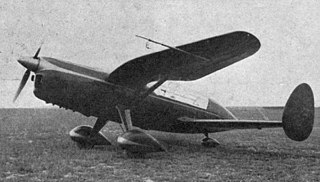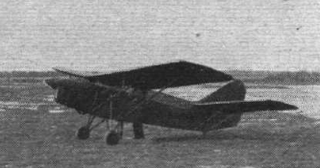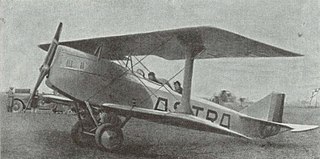Related Research Articles

The Lederlin 380L is an unconventional light aircraft developed in France in the 1960s, and marketed for homebuilding.
The Starck AS-37 is a two-seat biplane with unconventional wing and propulsion layouts. It was designed in France in the 1970s; though three were built and more than twenty sets of plans sold for home building, no AS-37s are active in 2012.
The Briffaud GB-10 Pou-Push was a Mignet style tandem wing single seat aircraft with a pusher configuration single engine. The sole example was built in France in the 1980s.
The Chasle LMC-1 Sprintair is an all-metal, single-seat sports light aircraft designed in France in the early 1970s and intended to be built by aero clubs from plans.
The Lioré et Olivier LeO 8, Lioré et Olivier LeO 8-Cau 2 or Lioré et Olivier LeO 8 CAN 2 was a French two seat, parasol wing monoplane night fighter and reconnaissance aircraft, built in 1923.
The Landray GL.01 is a small tandem-wing, side-by-side seat sport aircraft of the Mignet Pou-du-Ciel type. Built in the mid 1970s, the single example remains active.
The Langlois JL.2 was a three-winged agricultural aircraft built in France in 1979. It failed to sell and only one was built.
The Landray GL.03 Pouss Pou was a small, pusher configuration tandem wing aircraft built in France in the early 1980s. Only one was completed, though it was much modified.
The Piel CP-10 was a post-war French sports aircraft in the Pou du Ciel tradition and was the first design from Claude Piel to fly.
The Piel CP-40 Donald is a French homebuilt, single engine, single seat, high wing aircraft. It was first flown in the early 1950s, though the last of the three examples completed did not fly until almost forty years later.
The Potez 27 was a French reconnaissance biplane first flown in 1924. 175 were operated by the Polish Air Force, most built in Poland by PWS under licence. Others went to Romania, where they were also used as light bombers.
The Caudron C.251 Et-2 was a French tandem seat, open cockpit biplane designed as an intermediate trainer and built in 1931. It did not go into production.

The Caudron C.74 was a ten-seat, four engine passenger biplane built in France in 1922. It showed promise but the sole prototype crashed fatally in a competition and no more were completed.

The Albessard Triavion, sometimes known as the Peyret-Albessard Triavion, was a three surface aircraft, combining a tandem wing and conventional tailplane.

The Delanne 20-T was a French tandem wing aircraft designed as an aerodynamic model for a larger fighter aircraft. It was tested during 1939.

The SFCA Taupin was a French tandem-wing aircraft, designed to provide a simple, stable and safe aircraft able to take-off and land in small spaces.
The Duverne-Saran 01 was a twin engine, three seat touring aircraft built in France in the mid-1930s. Only one was completed.
The Leduc RL-12 was a French low power, economical, parasol wing, single seat aircraft. First flown in July 1939, its development was halted by World War II.

The Astra-Șeșefschi was a two-seat Romanian reconnaissance aircraft designed and built in 1923.

The Huff-Daland HD.8A was a small civil transport biplane carrying two passengers built in the U.S. in 1922. The otherwise identical HD-9A offered an alternative engine.
References
- 1 2 3 4 Taylor, John W. R. (1981). Jane's All the World's Aircraft 1981-1982. London: Jane's Information Group. p. 487. ISBN 0710607059.
- 1 2 3 Gaillard, Pierre (1991). Les Avions Francais de 1965 à 1990. Paris: Éditions EPA. p. 167. ISBN 2-85120-392-4.
- 1 2 Chillon, Jacques. Fox Pappa - Registre des avions Français amateur (2009 ed.). Brive: Ver Luisant. p. 165. ISBN 978-2-3555-1-066-3.